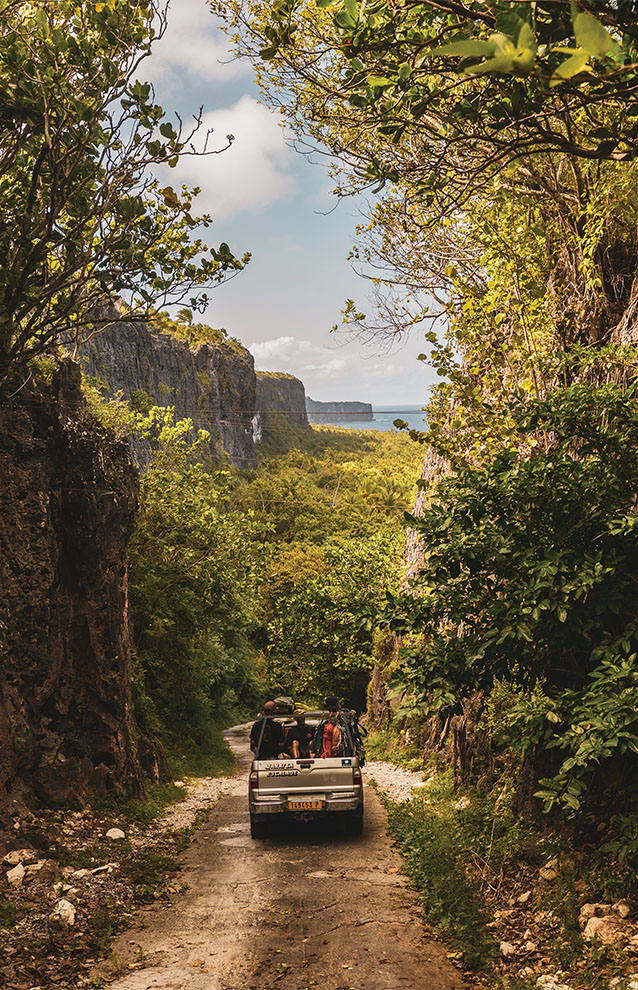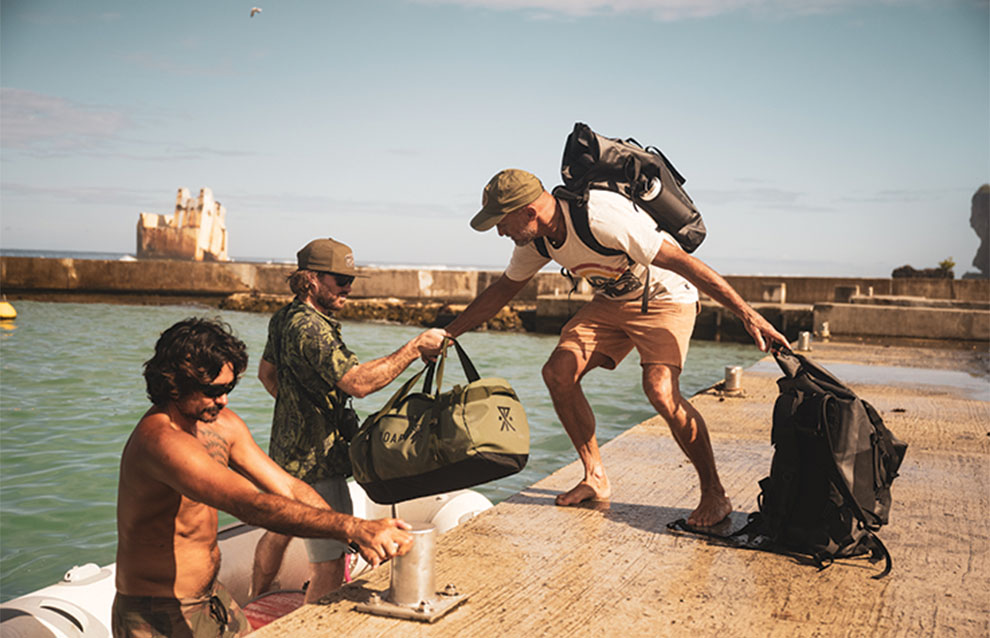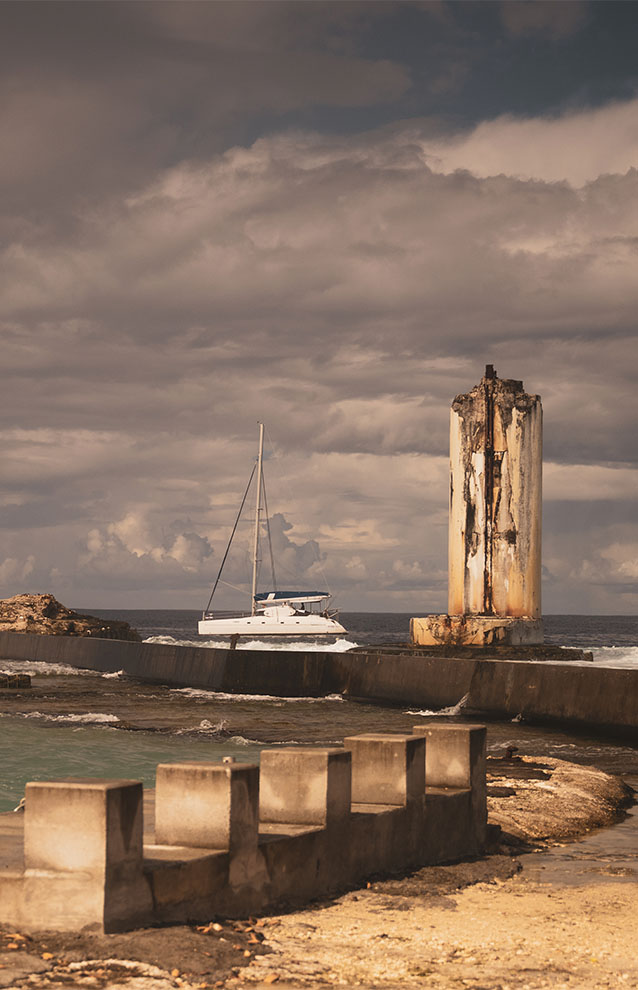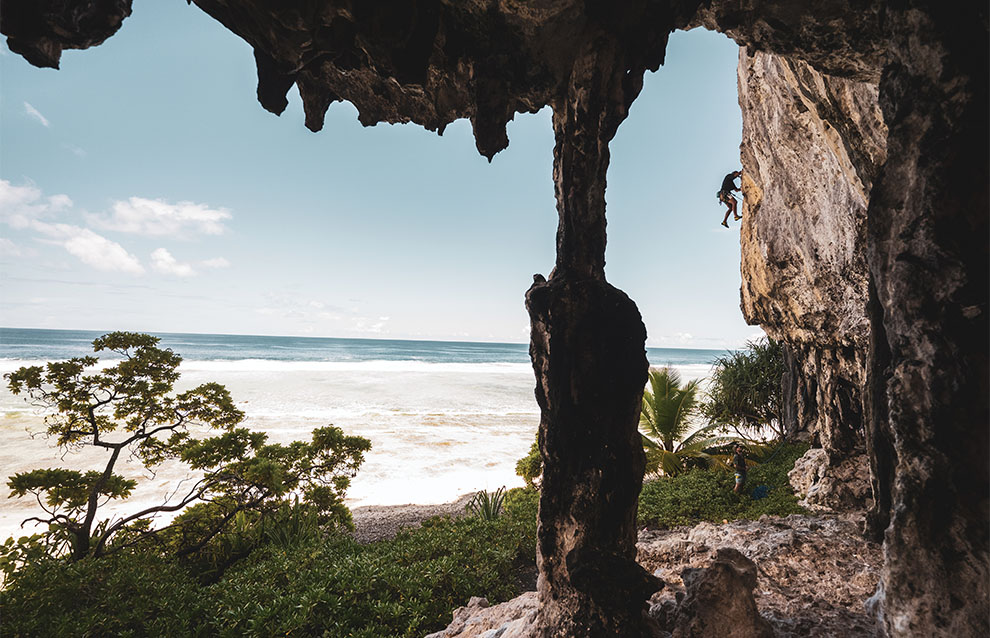 From the bow of our catamaran, the chalky white cliffs of Makatea look like a distant oncoming wave, frozen in place. As we sail closer in the soft light of dawn, it becomes clear why this lonely atoll is like no other in the region. Part of the Tuamotu archipelago of French Polynesia— the largest chain of atolls on the planet, sprawled across 350 square miles of the Pacific—the five-by-three-mile island rises 250 feet higher than its sea-level siblings. While most atolls are low-lying bracelets of dead coral surrounding a lagoon, Makatea is raised, courtesy of a tectonic shift two million years ago that created Tahiti, 130 miles away. This seismic event depressed the seafloor, lifting Makatea and creating the sheer cliffs we’re now approaching.
From the bow of our catamaran, the chalky white cliffs of Makatea look like a distant oncoming wave, frozen in place. As we sail closer in the soft light of dawn, it becomes clear why this lonely atoll is like no other in the region. Part of the Tuamotu archipelago of French Polynesia— the largest chain of atolls on the planet, sprawled across 350 square miles of the Pacific—the five-by-three-mile island rises 250 feet higher than its sea-level siblings. While most atolls are low-lying bracelets of dead coral surrounding a lagoon, Makatea is raised, courtesy of a tectonic shift two million years ago that created Tahiti, 130 miles away. This seismic event depressed the seafloor, lifting Makatea and creating the sheer cliffs we’re now approaching.
I’ve come with a group of professional climbers and surfers from the adventure brand Roark—atolls sometimes hide particularly good waves—but we’re really here for the cliffs. The limestone walls are pocked with holds, crags, dimples and cracks, which have recently put Makatea on many a rock climber’s bucket list—in part because this place shouldn’t exist. There’s nothing like it among Pacific islands because most of the rock in the region is too “chossy,” too brittle for climbing. Makatea is a complete anomaly.
Having sailed half of yesterday, through the night and into the morning, it’s taken us nearly twenty hours to get here from Tahiti—pretty good time, really, as it can take thirty hours when the weather and swells aren’t cooperating. Motoring along the outer reef, there’s no sign of civilization. Dense jungle caps the white cliffs. There are no resorts, bungalows, homes or development of any kind along the golden shores, lapped by cerulean seas. A shower—more a mist—passes through our sails and over the atoll, throwing a colossal, vivid rainbow over the entire island.
Makatea has been a world-class rock climbing destination for only about five years. Before that it was a hub for the phosphate mining industry. We motor up to the remains of Temao Harbor, once a bustling seaport for shipping the 11.5 million tons of phosphate extracted from Makatea between 1906 and 1966, most of it for fertilizer to replenish the depleted soil of Europe and the United States, and later Japan’s rice fields that had been ravaged by World War II. With only three moorings and a channel too narrow and shallow for our boat, we anchor outside the harbor, staring at the eerie ruins of an empire. Steel turret-like structures rot away next to other deteriorating machinery. On shore, we spot a couple of men beside a Hilux pickup truck parked among the ruins next to a pavilion with breeze-block walls.

Smith (left) and fellow climber Jeff Johnson (right) debark at Temao on Makatea, which is accessible only by boat.
A few of us pile into a four-person dinghy with duffel bags of climbing gear and try to make it to shore, but then double back in a panic. The swell is closing out the keyhole, so we wait for an opening, charging in dangerously a second time. With no airfield, the only way here is by an expensive four-hour speedboat from Rangiroa or a day’s sail from Tahiti. Makatea surely doesn’t make it easy on people wanting to get to it, but perhaps that’s part of its allure.
Heitapu Mai, a resident of Makatea and head guide of Club Makatea Escalade (Makatea Climbing Club), the island’s rock climbing outfit, greets our group, already in his helmet and harness. Handsome and smiling, Heitapu introduces himself, his brother Tarariki and two Americans, James Rebel and Allie Karney, who have been climbing for the last two weeks. He asks the surfers among us if we’ll be climbing—for most of us it’ll be our first time—and we shrug as if to say, “That’s an option?” He points to the gear—helmets, lines, gloves, carabiners, harnesses, shoes—hanging neatly from the truck’s racks and replies matter-of-factly, “Oui, oui, of course it is possible. There are routes for every level here.”
We follow Heitapu along the shoreline toward sections of the cliff shaded from the harsh sun until noon. While there are many climbing routes yet to discover and establish, the existing ones were pioneered by Heitapu’s climbing club and later by a group of a dozen international professional climbers who came here in 2019 to build a foundation for the sport. Heitapu himself had never climbed before 2018, when a visiting friend who worked for Acropol, a work-at-height company on Tahiti made up of rope specialists and mountaineers, saw the potential for epic climbing and helped Heitapu jump-start the scene.

“It’s pretty surprising to find excellent climbing like this in such an unlikely spot,” says Johnson, seen here with Smith preparing to climb. “It is so unlike all the islands surrounding it. It’s flanked by steep one- to three-hundred-foot limestone cliffs, whereas the other islands are merely sand atolls, barely above sea level.”
Later that year, Heitapu and the team from Acropol bolted forty routes on three different sections of cliffs. Around the same time, Erwan Le Lann, skipper of the French scientific and educational NGO vessel Maewan, stopped by Makatea on his way to the Marquesas. Le Lann, who was traveling with a couple of professional climbers, also saw the potential and told Heitapu he’d assemble a team to return and help bolt more routes. The following year, during the summer of 2019, the Maewan arrived with ten professional climbers, who for three weeks bolted sixty more routes with Club Makatea Escalade and Acropol. That visit culminated in an event called Makatea Vertical Adventure, in which 150 locals from the island and nearby atolls were invited to join in the launch of what was hoped would become a sustainable ecotourism endeavor. A 2020 film about the event had everyone in the climbing world suddenly searching for the speck on Google Maps called Makatea.
“I think when we started here,” says Heitapu, “local people thought that I was crazy. Rock climbing looks like a crazy thing. But it’s a crazy thing that you can share with people, you know?”
Drew Smith and Jeff Johnson, two accomplished professional climbers whom I’d arrived with, get right to work, asking Heitapu to point out the most difficult routes. One belays while the other one spiders up the steep faces.
Heitapu sets us newbies up at the base of a cliff section with large and abundant handholds, foot divots and grippy, textured rock—basically, rock climbing with training wheels. He wanders over to check on the pros and leaves us in the hands of James and Allie, who have been staying at Heitapu’s family-run pension, or guesthouse (one of two on Makatea). We sniff our helmets, tighten harnesses and squeeze into our climbing shoes, and James scales a hundred feet up while Allie waits with us to belay.
I make my way up the rock face trying not to look down and instead focus on the array of holds in the rock. I reach the top and James helps me up, guiding me into a shallow cave with a five-star view of the coastline while I wait for the others to ascend. When they do, we unclip and breathe it in. It’s magnificent, with birds soaring at eye level, flying in and out of valleys and narrow canyons. Heitapu appears and leads us around a portion of the cliff and through another cave to a prehistoric-looking gorge teeming with gargantuan palms and ferns. Makatea is one of the only atolls in French Polynesia with intact primary forest, and it’s home to some of the richest plant diversity in the archipelago. The island is home to seventy-seven native species, thirteen of them endemic to French Polynesia and four of them found only on Makatea.
 |
 |
(LEFT) After phosphate was discovered on Makatea in 1906, it became a hub of a global mining industry. In the mid-1950s, a gigantic mobile gateway called “the grasshopper” (seen here) was constructed at Makatea’s port of Temao to deliver ore directly from a train to cargo ships. PHOTO COURTESY OF LOUIS MOLET / TAHITI HERITAGE. (RIGHT) Temao as it looks today. When phosphate mining ended in 1966, the primary driver of the economy on Makatea—and a major source of revenue for French Polynesia—went with it. The population dropped from three thousand to less than a hundred almost overnight.
After rappelling back down to the beach, we take a dip to cool off in a small tidal gully of electric-blue water, then stroll over to the section of cliff where Drew and Jeff are still climbing. Drew rappels down, grinning ear to ear.
“That good?” I ask, wondering whether this whole thing is but a novelty for climbers of their caliber, who have literally named routes and mountain peaks around the world. Is this like that standing river wave in Germany? It’s good surf … for Germany.
“It’s really good rock,” says Drew. “It’s bullet-hard limestone. And when it comes to limestone, what you’re looking for are the blue streaks like they have here. Typically, beautiful blue limestone means good-quality rock. I think any climber would be impressed by this place. So far, I sure am.”
“The climbing on Makatea is actually amazing,” says Brette Harrington, a world-class professional climber who visited the island in 2022. “That limestone is some of the best you can find anywhere. The challenge is the humidity—because it’s so hot there, your fingers are constantly perspiring. You really have to use good chalk and take advantage of the early hours of the day before the sun hits. But as far as the actual climbing, if you go, you can find easy routes for beginners, all the way up to very challenging routes for advanced climbers.”
The view from the bed of Heitapu’s pickup truck while riding through Moumu, the only settlement on Makatea, is surreal. Corroded, burnt-umber machinery—structures, water towers, tools, gears, cogs, axles, engines—lie frozen in the brush on either side of the worn one-lane road, most of the relics completely swallowed by vines and ferns. Giant hooks from some kind of contraption claw at us from the forest; broken crane arms stretch out from the jungle like limbs reaching for help. Moumu, which has fifty residents, two pensions, a primary school and one restaurant, if you could call it that, feels like a ghost town.
But not completely. A few old men and women sip midday coffee outside of simple homes, seated around plastic tables covered with the floral-print cloth universal to Oceania. They wave and offer warm ia oranas (aloha) as we pass. Heitapu stops at his family’s pension where a handful of visiting climbers stay and picks up a couple of Canadian climbers. He shows us his equipment cellar, well stocked thanks to the hundreds of climbers who have left gear over the last few years, as we will.

Sustainable tourism, including rock climbing, has partly revived Makatea, where its fifty or so residents live a mostly subsistence lifestyle. Here, Johnson scales “La Rapapapaye” while Smith watches from below.
Halfway across the island, Heitapu pulls the Hilux over, and we follow him through the bush to a vast expanse of sunbaked, jagged limestone holes, many dangerously hidden by a thin layer of foliage. This clearing, which seen from above looks like a cratered no man’s land, as if shelled in a long and vicious war, is where for nearly sixty years his grandfathers, great-uncles and many other “diggers” excavated phosphate from the limestone tubes with only shovels, pickaxes and wheelbarrows. It was backbreaking and dangerous work, paid by the barrow, not by the day, as incentive to dig more. There was little relief from the South Pacific sun, and the often barefoot workers would be lowered into holes ranging from eighty to two hundred feet deep.
Following Heitapu, we skirt cautiously along the edge of the moonscape, which was once covered in a maze of wood planks on which workers rolled the wheelbarrows to conveyor belts and rail systems delivering the phosphate to the harbor and from there to wealthy, developed nations around the world.
Once upon a time on Makatea, there was a golden age. Through the first half of the twentieth century, it was “the place to be,” as Heitapu puts it. Before phosphate was discovered in 1906, it was a sleepy, typical Tuamotuan island of around 250 people living a subsistence lifestyle. After phosphate was found, with extraction beginning in 1911, La Compagnie Française des Phosphates de l’Océanie (CFPO) transformed Moumu into a company town, replete with infrastructure that dwarfed that of the far larger Tahiti island. Immigrant workers came from all over French Polynesia and the Pacific; the population ballooned to nearly four thousand. Narrow roads were paved, railways built. There were churches, shops, a boulangerie, hospital, library, nightclub, tennis courts, restaurants and two cinemas. “Two of them,” Heitapu repeats, raising his thumb and index finger for emphasis.
Then in 1966, as the phosphate industry was drying up in the Pacific, the French government decided to develop its nuclear weapons program, an endeavor that transformed (even more destructively) a small atoll called Moruroa in the far eastern corner of the Tuamotus, where nuclear testing would be conducted over the next thirty years. The CFPO shut down operations in a matter of days, literally shutting off the lights when Makatea’s power plant closed, leaving the mining industry’s remains to rust. Many of the workers transferred to Moruroa. Many went home to neighboring atolls like Tikehau, Rangiroa, Fakarava and Kaukura or headed south to Tahiti to start over. The CFPO paid their way to go where they wanted, and in a matter of weeks Makatea’s population shrank to fewer than fifty.

“It was definitely a really, really sad moment for the people on Makatea,” laments Heitapu.
“What did they do once everyone left?” I ask.
“They just returned back to nature,” Heitapu shrugs. “Back to the natural life. They hunted for coconut crabs, they fished and they bagged up copra for when the boat would come and collect the sacks for money. Fifty years, they did like this. 1966 until almost today, really.
“Since promoting climbing on the island, though, it’s been a boom,” he continues, “like a big tank of oxygen for the community, and now Makatea is somehow known all around the world. That was my goal.”
We head to the windward side of the island, shaded from the sun this time of day, for more climbing. The cliffs on this side offer even more challenging routes, with some inverted features for the experts. The potholed road leads down a hill past more disintegrating machinery and vehicles, and parallels a beach with rows of coconut trees. Anywhere else you’d see hotels and all-inclusive resorts , but there’s not a soul or home in sight. The dirt track ends after barely half a mile, and the two Canadians tell Heitapu where they’ll be and take a walkie-talkie.
The rest of us walk along the beach at the foot of the towering cliffs and set up a base camp beneath an overhang. Drew and Jeff nimbly make their way up different lines. Some of their maneuvers look like stationary karate kicks, posed to build leverage before pulling themselves vertically with what appears to be their heels. Wall yoga. Heitapu leads us to a nearby beginners’ route that’s incredibly fun albeit more challenging than the one we climbed earlier, requiring one to maneuver up a crack in the limestone as if pulling the rock apart the way you’d open curtains.
While rock climbers, often known for their lifestyle of “dirtbagging,” a non-pejorative term for those who live out of their vans to stay closer to climbing, are indeed a type of tourist, Heitapu is under no illusion that climbing will completely transform Makatea. He understands it’s a small number of visitors, comparatively, who clearly have to want it.
In 2022, he says, 650 to 700 people came to Makatea, mostly by catamaran from Tahiti, to partake in climbing and other outdoor activities. A couple of other guides on the atoll run stand up paddleboard tours, snorkeling/diving excursions and nature/mining site tours. There’s an incredible freshwater cave in the middle of the island unlike anything found elsewhere in French Polynesia, a draw for cavers. “It’s a good vision, I think,” says Heitapu. “Not massive tourism, but regular tourism. And tourism with a connection to nature, which, I think, is more sustainable.”
If you have neither the time nor the luxury to get on a catamaran to sail the roughly twenty-four hours from Tahiti, you can do what Brette Harrington did and fly from Papeete to Rangiroa, then hop on a speedboat and take the pricey, often bumpy four-hour open-ocean crossing. “The boat driver was like a race car driver,” recalls Harrington. “We were dodging swells, and at one point we had to go through the surf break on Rangiroa, and there were just huge waves breaking around us. It’s a wild ride. I was pretty scared. But the driver was spot-on. He even caught us some fish along the way.” Heitapu, however, sees the “adventure” of getting to Makatea as part of the draw, and the challenging access is a natural check on over-tourism, which for this island’s fragile ecosystem is clearly for the best.

Climbing has been a “boom, like a big tank of oxygen for the community,” says Heitapu Mai, the head of Club Makatea Escalade (seen at center with Smith and Johnson). “Now Makatea is somehow known around the world. That was my goal.”
“That’s why we keep the ocean option,” he explains. “We don’t want an airport. We’re not a lot of people here, so if we got a huge influx of tourism, it’d be a problem. By keeping the boat access, Makatea becomes a treasure. It becomes exceptional to come here. Once you arrive after twenty-four hours of navigation, maybe you’re a little seasick,” he smiles. “You’re happy to get here. You’ll appreciate it that much more.”
“I think you go to Makatea for the overall experience—not just the climbing,” says Charlotte Durif, a six-time world champion climber from France who visited in 2019 with the group aboard the Maewan. “The climbing definitely surprised me, with some super high-quality rock and neat features. Some of the climbing reminded me of the iconic Gorges du Tarn in France. But as soon as you put your foot on land there, you’re supporting the local economy and the ecotourism operation that Makatea’s offering. Also, I’m all for going off the beaten path, and Makatea is the epitome of that.”
We make our way along the reef and back to the Hilux in the dark, guided by headlamps and the half-moon’s steady glow.
“Still impressed?” I ask Drew, whose grin hasn’t left him all day. He nods yes.
“It’s kind of insane how it’s this unknown, little paradise—although if there were a whole bunch of resorts and stuff around, it wouldn’t be paradise. I guess because it’s just so far out there, you really gotta want it, as a climber. It’s a dreamy destination, but some would probably consider this roughing it.”
 |
 |
(LEFT) Dangerous excavations: Phosphate miners on Makatea in 1962 cart wheelbarrows loaded with phosphate sand along narrow footbridges spanning deep, limestone-walled pits. PHOTO COURTESY OF LOUIS MOLET / TAHITI HERITAGE. (RIGHT) Smith navigates the edges of the now empty pits, some more than a hundred feet deep. “It’s kind of eerie with all the old, decrepit buildings and rusted machinery,” says Johnson. “Hard to believe that at one time this island had more infrastructure than Papeete on Tahiti.”
I ask Heitapu how, if he’d really never climbed before 2018, he developed a passion for it so quickly and created such an extraordinary scene in so little time.
“I think Polynesian people love a challenge,” he says. “It’s in our blood. Sport is in our blood. We’re active people. I paddled canoe for ten years. When my brother and I discovered the climbing here and that feeling that you can have on a vertical cliff, my mind was blown.”


